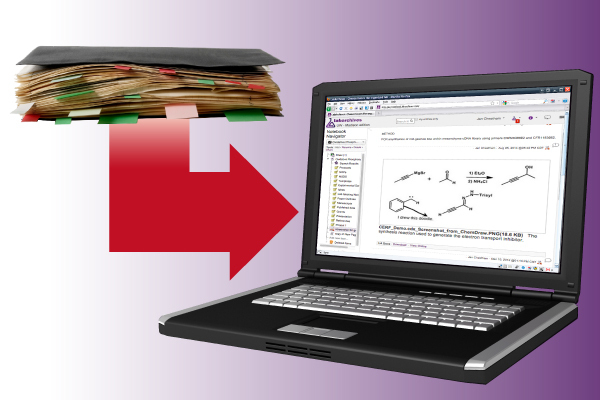Researchers embrace and reap benefits of Electronic Lab Notebooks

An Electronic Lab Notebook serves many of the same functions as a paper lab notebook, but offers additional capabilities such as searchability, integration with digital data sources, and access controls.
Photo illustration: Troy Slama/DoIT
In the fall of 2014, University of Wisconsin–Madison researchers gained a new option for storing and organizing experimental data, notes and procedures: the campus Electronic Lab Notebook (ELN) system. Since then, nearly 100 labs across campus have begun to use it.
Scientists who use the system on a regular basis — including faculty, staff and students — report many benefits, particularly with sharing information, accessing notebooks in a variety of locations and improved record keeping.
For example, faculty whose labs have adopted the notebook say it helps them stay on top of their lab’s research and keep tabs on how critical information is being recorded. Kristen Bernard, professor of pathobiological sciences in the School of Veterinary Medicine, says it’s now easier for her to regularly review her lab’s records, while Tim Hall, professor of medical physics, finds it simpler to “stay up to date on where things are headed and where we really are in our research.” Eric Yen, an assistant professor of nutritional sciences, says it’s “reassuring to be able to see that everyone is keeping their notebook in a standard format using the template we created.”
Students say the notebook has helped them keep better records.
“I can share or type anything, upload all my data and protocols, and I don’t have to print and tape manually into my notebook anymore,” says Mark Golob, a graduate student in the lab of biomedical engineering Professor Naomi Chesler. “Handwriting is no longer an issue.”
Some unexpected benefits have emerged, as well. For example, Fernando Moreira, a graduate student in Bernard’s lab, finds it easier to document his experimental setups in a digital notebook and better record “exactly how I set up my protocol so I can reproduce it next time.” The system allows him to include photos, which helped him identify a better time point for harvesting the mosquito eggs he uses in his research.
Ivan Rosado-Mendez, a postdoctoral researcher in Hall’s lab, says organizing his research in the system “puts things in perspective and makes it easy to jump between studies and get new ideas.”
While some students have found using an electronic notebook in a wet lab requires some special accommodations, they say it’s been easy to adapt. In some cases, they simply need to bring a well-protected laptop, tablet or printouts of protocols to the bench. Bernard’s lab found it helpful to use the notebook while working in a Biosafety Level 3 restricted area, from which paper records cannot be removed.
Another benefit of the system is that research records can be accessed from anywhere with an Internet connection, even while traveling or working off-site. Lindsey Moser, a scientist in Bernard’s lab, says “it’s useful to be able to write from home” because she can access the records for planning, thinking through results and drafting manuscripts and presentations.
The system also enables members of a research group to share their work with each other, as well as with collaborators across campus or at other institutions. Sharing all or part of a notebook is built into the interface, and it is easy to apply permissions and invite collaborators using their official email addresses.
David Nelson, a scientist in Yen’s lab, says the notebook is “the most efficient way for me to share information with people not in the lab.” Lindsey Drehfal, a researcher in Hall’s lab, was able to share information with her colleagues through the system while working remotely for several months.
Additionally, using templates and sharing protocols within the system can help labs standardize procedures and bring new lab members, including undergraduate students, up to speed quickly.
Labs using the system as their primary method of recording their research have reported that after the initial effort of setting up notebooks (which typically takes an hour or two), the learning curve for lab members was minimal. Some began to realize savings of time and money that would have been spent on paper notebooks and printouts of data fairly quickly.
“We are very pleased with our adoption of the ELN as a standard lab procedure and highly recommend it,” says Hall.
UW-Madison adopted the system based on the enthusiastic response of researchers who experimented with several electronic lab notebook products in campus pilots during 2012-13. The current system was selected after an extensive review by campus IT security and legal groups. The system is available free to UW–Madison faculty and their lab members.
Get more information or enroll
—Nicholas Tincher
Tags: research




